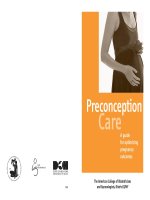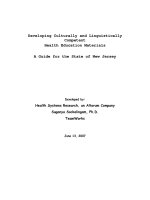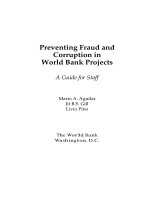Control engineering - a guide for beginners
Bạn đang xem bản rút gọn của tài liệu. Xem và tải ngay bản đầy đủ của tài liệu tại đây (1.74 MB, 132 trang )
Control Engineering
A guide for beginners
Manfred Schleicher
Frank Blasinger
Preface
This work is intended to be of practical assistance in control engineering technology. It will help
you to select and set up a suitable controller for various applications. It describes the different
types of controller and the options for setting them up. The explanations and definitions are provided without using advanced mathematics, and are mainly applied to temperature-control loops.
In this new and revised edition, Chapters 3 and 5 have been extensively updated.
We wish to thank our colleagues for their valuable support in writing this book.
Fulda, January 2003
Manfred Schleicher
JUMO GmbH & Co. KG, Fulda, Germany
Copying is permitted with source citation!
3rd Edition
Part number: 00323761
Book number: FAS 525
Printing date: 02.04
ISBN: 3-935742-01-0
Frank Blasinger
Inhalt
1
Basic concepts ............................................................................ 7
1.1
Introduction .................................................................................................. 7
1.2
Concepts and designations ........................................................................ 7
1.3
Operation and control .................................................................................. 7
1.4
The control action ...................................................................................... 11
1.5
Construction of controllers ....................................................................... 12
1.6 Analog and digital controllers ................................................................... 18
1.6.1 Signal types .................................................................................................. 18
1.6.2 Fundamental differences .............................................................................. 20
1.7
Manipulating devices ................................................................................. 23
1.8
1.8.1
1.8.2
1.8.3
Other methods of achieving constant values ..........................................
Utilizing physical effects ...............................................................................
Constructional measures .............................................................................
Maintaining constant values by operation ...................................................
1.9
Main areas of control engineering ............................................................ 27
25
25
25
26
1.10 Tasks of the control engineer .................................................................... 28
2
The process ................................................................................ 29
2.1
Dynamic action of technical systems ...................................................... 29
2.2
Processes with self-limitation ................................................................... 32
2.3
Processes without self-limitation ............................................................. 33
2.4
Processes with dead time ......................................................................... 35
2.5
2.5.1
2.5.2
2.5.3
Processes with delay .................................................................................
Processes with one delay (first-order processes) ........................................
Processes with two delays (second-order processes) .................................
Processes with several delays (higher-order processes) .............................
2.6
Recording the step response .................................................................... 41
2.7
Characteristic values of processes .......................................................... 43
2.8
Transfer coefficient and working point .................................................... 43
37
38
39
41
Inhalt
3
Continuous controllers .............................................................. 45
3.1
Introduction ................................................................................................ 45
3.2
3.2.1
3.2.2
3.2.3
P controller .................................................................................................
The proportional band ..................................................................................
Permanent deviation and working point ......................................................
Controllers with dynamic action ...................................................................
3.3
I controller ................................................................................................... 53
3.4
PI controller ................................................................................................ 54
45
47
49
52
3.5 PD controller ............................................................................................... 57
3.5.1 The practical D component - the DT1 element ............................................ 60
3.6 PID controller .............................................................................................. 61
3.6.1 Block diagram of the PID controller ............................................................. 62
4
Control loops with continuous controllers .............................. 63
4.1
Operating methods for control loops with continuous controllers ....... 63
4.2
Stable and unstable behavior of the control loop ................................... 64
4.3 Setpoint and disturbance response of the control loop ......................... 65
4.3.1 Setpoint response of the control loop .......................................................... 66
4.3.2 Disturbance response .................................................................................. 67
4.4
Which controller is best suited for which process? ................................ 68
4.5
4.5.1
4.5.2
4.5.3
4.5.4
4.5.5
4.5.6
Optimization ................................................................................................
The measure of control quality .....................................................................
Adjustment by the oscillation method ..........................................................
Adjustment according to the transfer function or process step response ...
Adjustment according to the rate of rise ......................................................
Adjustment without knowledge of the process ............................................
Checking the controller settings ..................................................................
69
70
71
72
75
76
77
Inhalt
5
Switching controllers ................................................................ 79
5.1
Discontinuous and quasi-continuous controllers ................................... 79
5.2
5.2.1
5.2.2
5.2.3
The discontinuous controller ....................................................................
The process variable in first-order processes ..............................................
The process variable in higher-order processes ..........................................
The process variable in processes without self-limitation ...........................
5.3
Quasi-continuous controllers: the proportional controller .................... 86
80
81
83
85
5.4 Quasi-continuous controllers: the controller with dynamic action ....... 89
5.4.1 Special features of the switching stages ..................................................... 90
5.4.2 Comments on discontinuous and quasi-continuous
controllers with one output .......................................................................... 90
5.5 Controller with two outputs: the 3-state controller ................................
5.5.1 Discontinuous controller with two outputs ...................................................
5.5.2 Quasi-continuous controller with two outputs,
as a proportional controller ..........................................................................
5.5.3 Quasi-continuous controller with two outputs and dynamic action ............
5.5.4 Comments on controllers with two outputs .................................................
91
91
93
94
94
5.6
The modulating controller ......................................................................... 95
5.7
Continuous controller with integral motor actuator driver .................... 98
6
Improved control quality through special controls .............. 101
6.1
Base load .................................................................................................. 101
6.2
Power switching ....................................................................................... 103
6.3
Switched disturbance correction ........................................................... 104
6.4
Switched auxiliary process variable correction .................................... 107
6.5
Coarse/fine control .................................................................................. 107
6.6
Cascade control ....................................................................................... 108
6.7
Ratio control ............................................................................................. 110
6.8
Multi-component control ......................................................................... 111
Inhalt
7
Special controller functions .................................................... 113
7.1
Control station / manual mode ............................................................... 113
7.2
Ramp function .......................................................................................... 114
7.3
Limiting the manipulating variable ......................................................... 114
7.4
Program controller ................................................................................... 115
7.5
Self-optimization ...................................................................................... 116
7.6
Parameter/structure switching ............................................................... 118
7.7
Fuzzy logic ................................................................................................ 118
8
Standards, symbols, literature references ............................ 121
1 Basic concepts
1.1
Introduction
Automatic control is becoming more and more important in this age of automation. In manufacturing processes it ensures that certain parameters, such as temperature, pressure, speed or voltage,
take up specific constant values recognized as the optimum, or are maintained in a particular relationship to other variables. In other words, the duty of control engineering is to bring these parameters to certain pre-defined values (setpoints), and to maintain them constant against all disturbing
influences. However, this apparently simple duty involves a large number of problems which are
not obvious at first glance.
Modern control engineering has links with almost every technical area. Its spectrum of application
ranges from electrical engineering, through drives, mechanical engineering, right up to manufacturing processes. Any attempt to explain control engineering by referring to specialized rules for each
area would mean that the control engineer has to have a thorough knowledge of each special field
in which he has to provide control. This is simply not possible with the current state of technology.
However, it is obvious that there are certain common concepts behind these specialized tasks. It
soon becomes clear, for example, that there are similar features in controlling a drive and in pressure and temperature control: these features can be described by using a standard procedure. The
fundamental laws of control engineering apply to all control circuits, irrespective of the different
forms of equipment and instruments involved.
A practical engineer, trying to gain a better understanding of control engineering, may consult various books on the subject. These books usually suggest that a more detailed knowledge of control
engineering is not possible, without extensive mathematical knowledge. This impression is completely wrong. It is found again and again that, provided sufficient effort is made in presentation, a
clear understanding can be achieved, even in the case of relationships which appear to demand an
extensive mathematical knowledge.
The real requirement in solving control tasks is not a knowledge of many formulae or mathematical
methods, but a clear grasp of the effective relationships in the control circuit.
1.2
Concepts and designations
Today, thanks to increasing standardization, we have definite concepts and designations for use in
control engineering. German designations are laid down in the well-known DIN Standard 19 226
(Control Engineering, Definitions and Terms). These concepts are now widely accepted in Germany.
International harmonization of the designations then led to DIN Standard 19 221 (Symbols in control engineering), which permits the use of most of the designations laid down in the previous standard. This book keeps mainly to the definitions and concepts given in DIN 19 226.
1.3
Operation and control
In many processes, a physical variable such as temperature, pressure or voltage has to take up a
specified value, and maintain it as accurately as possible. A simple example is a furnace whose
temperature has to be maintained constant. If the energy supply, e.g. electrical power, can be varied, it is possible to use this facility to obtain different furnace temperatures (Fig. 1). Assuming that
external conditions do not change, there will be a definite temperature corresponding to each value
of the energy supply. Specific furnace temperatures can be obtained by suitable regulation of the
electrical supply.
However, if the external conditions were to change, the temperature will differ from the anticipated
value. There are many different kinds of such disturbances or changes, which may be introduced
into the process at different points. They can be due to variations in external temperature or in the
JUMO, FAS 525, Edition 02.04
7
1 Basic concepts
Fig. 1: Operation and control
8
JUMO, FAS 525, Edition 02.04
1 Basic concepts
heating current, or caused by the furnace door opening. This type of temperature control takes no
account of the actual furnace temperature, and a deviation from the required value may not be noticed by the operator.
Some form of control is necessary if the furnace temperature has to maintain its value in spite of
changes in external conditions, or non-constant disturbances which cannot be predicted. In its
simplest form the control may just be a thermometer which measures and indicates the actual furnace temperature. The operator can now read the furnace temperature, and make appropriate adjustments to the energy supply, in the event of a temperature deviation (Fig. 1).
The energy supply is now no longer pre-determined, but is linked to the furnace temperature. This
measure has converted furnace operation into furnace control, with the operator acting as the controller.
Control involves a comparison of the actual value with the desired value or setpoint. Any deviation
from the setpoint leads to a change to the energy supply. The energy input is no longer fixed, as is
the case with simple operation, but depends on the actual process value attained. We refer to this
as a closed control loop (Fig. 2)
If the connection to the temperature probe is broken, the control loop is open-circuited. Because
there is no feedback of the process value, an open control loop can only be used for operation.
Fig. 2: The closed control loop
The control loop has the following control parameters (the abbreviations conform to DIN 19 226):
Process variable (process value, PV) x: the process value is the control loop variable which is
measured for the purpose of control and which is fed into the controller. The aim is that it should always be made equal to the desired value through the action of the control (example: actual furnace
temperature).
Desired value (setpoint, SP) w: the predetermined value at which the process variable has to be
maintained through the action of the control (example: desired furnace temperature). It is a parameter which is not influenced by the control action, and is provided from outside the control loop.
Control difference (deviation) e: difference between desired value and process variable e = w - x
(example: difference between required and actual furnace temperature).
JUMO, FAS 525, Edition 02.04
9
1 Basic concepts
Disturbance z: an effect whose variation exerts an unfavorable influence on the process value (influence on the controlled variable through external effects).
Controller output YR: it represents the input variable of the manipulating device (the manipulator
or actuator).
Manipulating variable y: a variable through which the process value can be influenced in the required way (e.g. heating power of the furnace). It forms the output of the control system and, at the
same time, the input of the process.
Manipulation range Yh: the range within which the manipulating variable can be adjusted.
Control loop: connection of the output of the process to the input of the controller, and of the controller output to the process input, thus forming a closed loop.
It consists of controller, manipulator and process.
The physical units involved can differ widely:
process value, setpoint, disturbance and deviation usually have the same physical units such as
°C, bar, volts, r.p.m., depth in metres etc. The manipulating variable may be proportional to a heating current in amps or gas flow in m3/min, or is often a pressure expressed in bar. The manipulation
range depends on the maximum and minimum values of the manipulating variable and is therefore
expressed in the same units.
10
JUMO, FAS 525, Edition 02.04
1 Basic concepts
1.4
The control action
The basic task of the controller is to measure and prepare the process value PV, and compare it
with the setpoint SP; as a result it produces the appropriate manipulating variable MV. The controller has to perform this action in a way which compensates for the dynamic characteristics of the
controlled process. This means that the process value PV should reach the setpoint SP as rapidly
as possible, and then fluctuate as little as possible about it.
The action of the controller on the control loop is characterized by the following parameters:
- the overshoot:
Xo ,
- the approach time:
Ta, the time taken for the process value PV to reach the
new setpoint SP for the first time,
- the stabilization time: Ts,
- and also agreed tolerance limits ± ∆x (see Fig. 3)
Fig. 3: Criteria for control action
The controller is said to have “stabilized” when the process is operating with a constant manipulating variable MV, and the process value PV is moving within the agreed tolerance band ± ∆x.
In the ideal case the overshoot is zero. In most cases this cannot be combined with a short stabilization time. In certain processes, e.g. speed controls, rapid stabilization is important, and a slight
overshoot beyond the setpoint can be tolerated. Other processes, such as plastics production machinery, are sensitive to a temperature overshoot, since this can quite easily damage the tool or the
product.
JUMO, FAS 525, Edition 02.04
11
1 Basic concepts
1.5
Construction of controllers
The choice of a suitable controller depends essentially on its application. This concerns both its
mechanical features and its electrical characteristics. There is a wide range of different designs and
arrangements, so only a few will be discussed here. The discussion is limited to electronic controllers, and excludes mechanical and pneumatic control systems. The user, who is faced with choosing a controller for his particular application, will be shown initially which types are available. The
listing is not intended to be comprehensive.
Mechanical variations:
- Compact controllers (process controllers) contain all the necessary components (e.g. display,
keypad, input for setpoint etc.) and are mounted in a case which includes a power supply. The
housing usually has one of the standard case sizes, 48mm x 48mm, 48mm x 96mm,
96mm x 96mm or 72mm x 144mm.
- Surface-mounting controllers are usually installed inside control cabinets and mounted on a
DIN-rail or the like. Indicating devices such as process value display or relay status LEDs are not
usually provided, as the operator does not normally have access to these controllers.
- Rack-mounting controllers are intended for use in 19-inch racks. They are only fitted with a
front panel and do not have a complete housing.
- Card-mounted controllers consist of a microprocessor with suitable peripherals, and are used
in various housing formats. They are frequently found in large-scale installations in conjunction
with central process control systems and PLCs. These controllers again have no operating or indicating devices, since they receive their process data via an interface from the central control
room through software programs.
Functional distinctions
The terms that are used here are covered and explained in more detail in later chapters (see Fig. 4).
- Continuous controllers
(usually referred to as proportional or analog controllers)
Controllers which receive a continuous (analog) input signal, and produce a controller output
signal that is also continuous (analog). The manipulating signal can take on any value within the
manipulation range. They usually produce output signals in the range 0 — 20mA, 4 — 20mA or
0 — 10V. They are used to control valve drives or thyristor units.
- Discontinuous controllers
2-state controllers (single-setpoint controllers) with one switching output are controllers that produce a discontinuous output for a continuous input signal. They can only switch the manipulating
variable on and off, and are used, for instance, in temperature-control systems, where it is only
necessary to switch the heating or cooling on or off.
3-state controllers (double-setpoint controllers) have two switching control outputs. They are similar to 2-state controllers but have two outputs for manipulating variables. These controllers are
used for applications such as heating/cooling, humidifying/dehumidifying etc.
12
JUMO, FAS 525, Edition 02.04
1 Basic concepts
- Quasi-continuous controllers
Quasi-continuous controllers with one switching output are controllers that achieve a quasicontinuous action. The average value of the controller output over a defined time interval shows
approximately the same time-dependent variation as a continuous controller. Applications are, for
instance, temperature control (heating or cooling), where improved control-loop performance is required. In practice, quasi-continuous controllers with one switching output are also described as 2state controllers.
Quasi-continuous controllers with two switching outputs can steer a process in opposing directions (for example, heating/cooling or humidifying/dehumidifying). These controllers also
achieve a quasi-continuous action, by pulsing the switched outputs. In practice, all controllers that
use two outputs to steer a process in opposing directions are referred to as 3-state controllers.
Here the outputs need not necessarily be switched, but can be continuous.
- Modulating controllers
Modulating controllers have two switching outputs and are specially designed for motorized actuators which are used, for instance, to drive a valve to the open and closed positions.
- Actuating controllers
Actuating controllers are also used for motorized actuators and again have two switching outputs.
They differ from modulating controllers by requiring feedback of the actuator position (stroke retransmission).
JUMO, FAS 525, Edition 02.04
13
1 Basic concepts
Fig. 4: Difference in controller functions
14
JUMO, FAS 525, Edition 02.04
1 Basic concepts
All these types of controller (apart from the discontinuous controller) can be implemented with different forms of dynamic response. This is often referred to as the “controller structure”. The terms
used are P, PI, PD or PID controllers (see Fig. 5).
Different setpoint arrangements
The setpoint can be set manually on the controller by means of a potentiometer, or by using keys
to input digital values. The setpoint is indicated in either analog form (pointer of a setpoint knob), or
digitally as a numerical value.
Another possibility is the use of an external setpoint. The setpoint is then fed in as an electrical signal (e.g. 0 — 20mA) from some external device. As well as these analog signals, it is also possible
to use digital signals for setting the setpoint. The signals are fed into the controller through a digital
interface and can be derived from another digital instrument, or from a computer linked to the controller. If this external setpoint operates according to a fixed time sequence (program), this is also
referred to as program or sequence control.
JUMO, FAS 525, Edition 02.04
15
1 Basic concepts
Fig. 5: Typical step responses
Evaluation of the process variable
The process variable must be available as an electrical signal. Its form depends on the sensor used
and on the processing of this signal. One possibility is to connect the transducer signal (sensor,
probe) directly to the controller input. The controller must then be capable of processing this signal;
in many temperature probes the output signal is not a linear function of the temperature, and the
controller must have a suitable linearization facility.
16
JUMO, FAS 525, Edition 02.04
1 Basic concepts
The other possibility is the use of a transmitter.
The transmitter converts the sensor signal into a standard signal (0 — 20mA, 0 — 10V) and usually
also linearizes the signal. In this case the controller need only have an input for standard signals.
The process value is normally displayed on the controller. This can be in the form of a digital display (numerical indication), which has the advantage of being readable from a longer distance. The
advantage of the analog display (pointer movement) is that trends such as rising or falling of the
process variable are clearly visible, as well as the position within the control range.
Fig. 6: Example for external connections to a controller
In many cases the process value requires further processing, e.g. for a recorder or for remote indication. Most controllers provide a process value output where the process variable is given out as
a standard signal.
In order to signal movements of the process variable above or below certain values, the controllers
are provided with so-called limit comparators (limit value or alarm contacts), which provide a signal
if the process value infringes set limits. This signal can then be used to trigger alarms or similar
equipment.
JUMO, FAS 525, Edition 02.04
17
1 Basic concepts
1.6
Analog and digital controllers
1.6.1 Signal types
Technical systems can be classified according to the type of signals at their inputs and outputs.
The signals differ in their technical nature. In control systems we often find temperature, pressure,
current or voltage as signal carriers which, at the same time, determine the units of measurement.
The signals can be divided into different types, depending on their range of values and variation
with time.
Fig. 7: Various signal forms
18
JUMO, FAS 525, Edition 02.04









